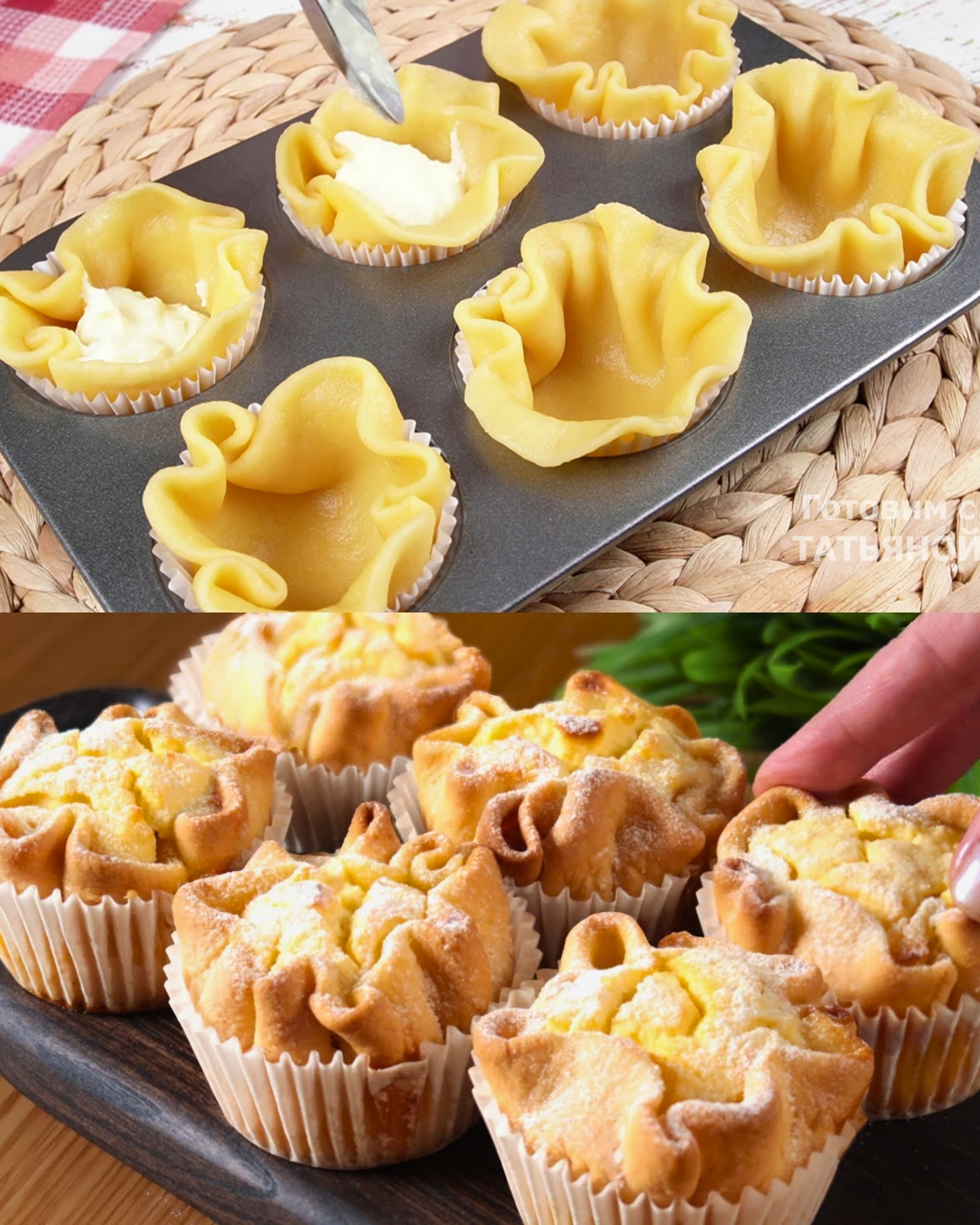Cottage cheese and ricotta pastry pockets are a delightful treat that combines a tender, slightly sweet dough with a creamy and luscious filling. This versatile recipe is a classic, loved by generations and perfect for any occasion, whether as a breakfast indulgence, a tea-time snack, or a light dessert. The combination of textures and flavors—soft and flaky dough encasing a smooth, vanilla-scented cheese filling—is universally appealing and guaranteed to satisfy your sweet tooth.
These pastries are steeped in culinary tradition, often appearing in European households where baking is a shared, familial ritual. The simplicity of the ingredients and the straightforward preparation process make them accessible to bakers of all skill levels. Yet, the result is so rewarding that they feel indulgent and elegant. With this recipe, you’ll create something timeless, delicious, and endlessly comforting.
Full Recipe:
Ingredients
For the Dough
- 1 egg
- 3 tablespoons (40 grams) sugar
- 1 pinch salt
- Vanilla (to taste)
- 2 tablespoons (25 ml) vegetable oil
- 1 1/4 cups (150 grams) all-purpose flour (add gradually)
For the Filling
- 1 cup (250 grams) cottage cheese or ricotta
- 1 egg
- 1/4 cup (50 grams) sugar
- Vanilla (to taste)
Steps to Make Cottage Cheese and Ricotta Pastry Pockets
Preparation Time: 15 minutes
Cooking Time: 25 minutes
Total Time: 40 minutes
Step 1: Prepare the Dough
- In a mixing bowl, whisk the egg, sugar, salt, and vanilla until the mixture is smooth and slightly frothy.
- Add the vegetable oil and mix well.
- Gradually incorporate the flour, mixing after each addition, until a soft dough forms. The dough should be pliable and slightly sticky but not overly wet.
- Cover the dough with a clean kitchen towel or plastic wrap and let it rest for 10 minutes while you prepare the filling.
Step 2: Prepare the Filling
- In another bowl, combine the cottage cheese or ricotta, egg, sugar, and vanilla.
- Mix thoroughly until the filling is smooth and well-combined. If the mixture appears too watery, you can strain the cheese beforehand or add a teaspoon of flour to thicken it slightly.
Step 3: Assemble the Pastries
- Preheat your oven to 350°F (180°C) and line a baking sheet with parchment paper.
- Lightly flour your work surface and roll out the dough to a thickness of about 1/8 inch (3–4 mm).
- Cut the dough into circles or squares using a cookie cutter or knife, depending on your preferred shape.
- Place a small spoonful of the cheese filling in the center of each dough piece. Be careful not to overfill to prevent leakage during baking.
- Fold the dough over the filling to create a pocket, sealing the edges firmly by pressing them together with your fingers or a fork.
Step 4: Bake the Pastries
- Arrange the pastries on the prepared baking sheet, leaving space between them.
- Optionally, brush the tops with an egg wash for a golden finish.
- Bake for 20–25 minutes, or until the pastries are lightly golden and puffed.
Step 5: Cool and Serve
Allow the pastries to cool slightly before serving. They can be enjoyed warm or at room temperature, depending on your preference.
Why This Recipe is Timeless
The cottage cheese and ricotta pastry pockets are a testament to the enduring charm of simple, homemade desserts. These pastries have been a part of many families’ culinary traditions, handed down through generations with slight variations to suit personal tastes. Their timeless appeal lies in their balance of simplicity and elegance: they’re easy to prepare yet sophisticated enough to impress guests.
This recipe is highly versatile, allowing you to experiment with fillings like fruit preserves, chocolate, or even savory options such as spinach and feta. It’s this adaptability that ensures these pastries remain relevant across cultures and eras. Whether you’re baking them for a family gathering, a holiday celebration, or just to treat yourself, these pastries never fail to evoke feelings of comfort and nostalgia.
Nutritional Information (Per Serving)
Serving Size: 1 pastry (approx. 50g)
- Calories: 140 kcal
- Total Fat: 6g
- Saturated Fat: 2g
- Cholesterol: 35mg
- Sodium: 50mg
- Total Carbohydrates: 17g
- Sugars: 8g
- Protein: 4g
FAQs
1. Can I use only one type of cheese for the filling?
Absolutely! You can use either cottage cheese or ricotta, depending on your preference. Ricotta tends to be creamier, while cottage cheese offers a slightly more textured filling.
2. How do I prevent the filling from leaking?
Ensure you don’t overfill the pastries and seal the edges firmly. Using a fork to press the edges together can create a tighter seal.
3. Can I make these pastries ahead of time?
Yes, you can prepare the dough and filling in advance. Store the dough in the fridge for up to 2 days and assemble the pastries when ready to bake.
4. Are there variations to this recipe?
Certainly! Add lemon zest to the filling for a zesty twist, or incorporate dried fruits like raisins. You can also sprinkle the pastries with powdered sugar or glaze them with icing.
Tips for Perfect Pastry Pockets
- Don’t Overwork the Dough: Overmixing can make the dough tough. Handle it gently for the best texture.
- Adjust Sweetness to Taste: Feel free to modify the sugar levels in the filling if you prefer a less sweet or more indulgent flavor.
- Experiment with Shapes: Use different cutters to make fun shapes, especially if baking with kids.
- Monitor Baking Time: Keep an eye on the pastries in the oven to avoid overbaking, as this can dry them out.
Storage Tips
Room Temperature
Store the pastries in an airtight container for up to 2 days.
Refrigeration
Refrigerate in a sealed container for up to 5 days. Reheat in a low oven or microwave before serving for the best texture.
Freezing
Freeze unbaked pastries on a baking sheet, then transfer them to a freezer-safe bag. Bake from frozen, adding a few extra minutes to the cooking time.
Conclusion
Cottage cheese and ricotta pastry pockets are more than just a recipe—they’re a celebration of tradition, simplicity, and the joy of baking. Each bite encapsulates a rich culinary history, reminding us of the warmth of home and the love that goes into creating food to share.
Their timelessness lies in their adaptability. These pastries cater to all tastes and occasions, whether you’re seeking a comforting treat, a festive centerpiece, or a way to spend quality time in the kitchen. From their tender, golden crust to their creamy, indulgent filling, these pastry pockets prove that even the simplest ingredients can create something extraordinary.
Baking these pastries is not just about following a recipe; it’s about embracing the process and cherishing the memories created along the way. So gather your ingredients, roll up your sleeves, and enjoy the magic of transforming basic pantry staples into a dessert that will delight your senses and warm your heart. These pastry pockets are more than a treat—they’re a timeless treasure to be shared and savored.

